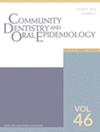Dental caries is one of the most prevalent chronic non-communicable diseases worldwide. There is a lack of evidence, especially in adult populations, documenting caries disease progression considering lesion severity, activity and tooth surface-level characteristics. The study aimed to investigate the extent to which primary active caries lesions in adults affect caries lesions progression compared with inactive caries lesions over a 2-year follow-up period, considering their severity, surface and tooth type.
A prospective study data set from a cohort of workers in a factory in Belarus were used. Participants aged 18–64 years with 20 or more natural teeth were included in the study. The participants were clinically examined twice within an interval of 2 years and completed a self-reported questionnaire. One calibrated examiner evaluated caries lesions using the International Caries Detection and Assessment System (ICDAS) and the Nyvad system. The primary outcome was caries lesions' progression. The lesion was classified as ‘progressed’ if it turned to a more advanced severity stage, was restored or missing/extracted due to caries. A multilevel Poisson regression was used to estimate the association between baseline caries lesions' characteristics and caries lesion progression.
Out of 495 participants, 322 people completed clinical examinations at baseline and 2 years later, with an attrition rate of 35%. The prevalence of active DS1-6 and DS5-6 lesions at the baseline was 83.8% and 64.8%, respectively. In 2 years, 24% of active non-cavitated and 31% of active micro-cavitated/shadowed caries lesions progressed, while 15% of inactive caries lesions, non- or micro-cavitated/shadowed, progressed. The adjusted rate ratio (RR) for ICDAS3 + 4 caries lesions progression was 1.41 (CI 95% 1.16, 1.70) than ICDAS1 + 2 lesions. The RR for ICDAS1 + 2, active and ICDAS3 + 4, active lesions was 1.78 (CI 95%, 1.40, 2.27) and 1.97 (CI 95%, 1.53, 2.55), respectively than ICDAS1 + 2, inactive lesions. The RR for caries lesions progression on proximal surfaces and on pits and fissures was 1.57 (CI 95%, 1.30, 1.89) and 1.37 (CI 95%, 1.11, 1.67), respectively than smooth surface lesions.
In caries active adults over 2 years, most non- and micro-cavitated/shadowed active and inactive caries lesions did not progress. Among caries lesions that showed progression, more severe lesions were more likely to progress than less severe lesions; active lesions were more likely to progress than inactive lesions. Pit and fissure caries lesions and proximal lesions were more likely to progress than smooth surface lesions.


